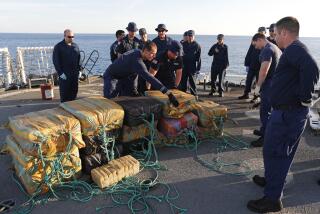A drug’s worrisome detour
- Share via
MADRID — A landmark shift in trafficking routes has transformed West Africa into a hub for cocaine smuggled from South America to a booming European market, anti-drug officials on three continents say.
Traffickers have established a haven and transit area along the Gulf of Guinea to elude aggressive efforts to seize cocaine headed to Europe. Anti-drug officials fear the new route will worsen lawlessness in African countries already overwhelmed by crime, poverty and instability.
Colombian gangsters have brought their swagger to the tiny West African country of Guinea-Bissau, setting up elaborate front companies, tooling around in flashy cars and allegedly buying high-level protection. The use of drug “mules” has increased dramatically: A single flight arriving in Amsterdam from Morocco in December carried 32 West African passengers who had swallowed cocaine packets or concealed them in their luggage.
“What was seen before as a threat has become a reality,” said Lt. Juan Llorente, an intelligence analyst for Spain’s paramilitary Guardia Civil.
On April 1, eight European nations will launch a military-law enforcement task force targeting cocaine traffic from Africa. The Maritime Analysis Operations Center based in Lisbon will team police, navy and customs resources, a model similar to a U.S. interdiction unit in Florida.
The United States is the world’s top market for cocaine, but use is declining. In Europe, demand has hit all-time highs, led by Britain, Spain, Italy and the Netherlands. A kilo (2.2 pounds) of cocaine brings about $45,000 in Europe, compared with about $25,000 in the U.S.
Because of historic ties to Latin America, the Iberian Peninsula remains the gateway to Europe. But aggressive Spanish and British patrols have intercepted numerous shiploads headed for a smuggling corridor on Spain’s northwestern coast, prompting traffickers to turn to Africa.
“Effective law enforcement is a particular challenge in Africa due to the sheer number of containers that transit through the seaports, the lack of trained inspectors and investigative intelligence, weak governments and the widespread practice of corruption,” Michael Braun, chief of operations for the U.S. Drug Enforcement Administration, told Congress last year.
Traffickers stockpile cocaine in countries such as Cape Verde, Guinea-Bissau, Guinea, Togo, Benin, Ghana, Nigeria, Senegal and Mauritania. It is then moved north, often to clandestine landing zones on the coasts of Spain and Portugal, or commercial ports such as Barcelona, Rotterdam and Antwerp.
Smugglers use fishing vessels and commercial ship containers, and occasionally enlist Moroccan smugglers to cross the Mediterranean. Intelligence indicates that small planes and trucks, the latter plying desert contraband trails, transport loads to North Africa, DEA officials say.
The partnerships combine South American suppliers, transport specialists predominantly from Nigeria and Ghana, and European distributors, officials say. Colombian traffickers, whether freelancers or cartel operatives, are popping up in remote African locales.
“There are so many Colombians in Guinea-Bissau,” said a DEA official who asked not to be identified. “They are running supposedly legit businesses, driving Mercedeses. And they have informants -- they know when the DEA shows up.”
The former Portuguese colony, one of the 10 poorest nations in the world, lacks a secure prison, border controls or police labs.
“All the institutions have collapsed,” said Koli Kouame of Ivory Coast, secretary of the U.N.’s International Narcotics Control Board.
Guinea-Bissau police firing guns in the air captured two Colombians unloading 1,500 pounds of cocaine in September. After a police chief announced the seizure, he was threatened by fellow officials allegedly allied with Colombian traffickers. Authorities refused to let a DEA agent see the drugs or the suspects, whom a judge released, U.S. and European investigators say.
Colombians also set up a fish-processing factory, where in 2004 police found arms, drugs and a clandestine landing strip. Experts worry that traffickers could eventually smuggle in precursor chemicals and set up labs, enabling them to ship coca base across the Atlantic instead of the more expensive finished product.
In addition, Guinea-Bissau is selling some of its islands, raising fear that drug lords could buy one, Antonio Mazzitelli, regional representative for the United Nations Office on Drugs and Crime, said in Senegal.
Even in comparatively stable Ghana, top officials were accused last year of protecting a Venezuelan drug lord. Ghanaian police recorded the continent’s biggest cocaine bust last year, arresting Ghanaian and Nigerian suspects with a Mercedes van containing almost 2 tons of the drug concealed in boxes of fish.
Misery, disease and strife make it difficult for many African states to devote much energy to anti-drug efforts, Kouame said. “If you have a hierarchy of concern, this would not be No. 1 or 2 or 3 for them,” he said. “In the past five years, countries have made great anti-drug efforts. But you have so many calamities here and there that you can understand that countries devote resources to other things.”
Narcotics seizures in West and Central Africa jumped sixfold in 2004, according to the Office on Drugs and Crime. But it said in a report last year that “only a very small proportion of the cocaine passing through the continent is actually being seized.”
Portuguese police confiscated 32 tons last year, twice the total of the previous year. They attributed the record amount largely to intercepted loads from Africa.
The Africa-Europe route developed because of geography, economics, interdiction and enterprising criminals. Criminal organizations from around the world do business with Colombian traffickers, said Gen. Oscar A. Naranjo of Colombia’s national police, and both leftist guerrillas and their right-wing paramilitary enemies take part in the drug trade.
Cocaine also leaves for Africa from Brazil and Venezuela, which U.S. and Colombian officials say has become a sanctuary for smugglers.
William Brownfield, U.S. ambassador to Venezuela, said recently that the volume of drugs transiting that country has increased fivefold since 2001 to 250 tons a year, a figure disputed by the government of President Hugo Chavez. Half goes to the United States and half to Europe, officials say.
In September, the DEA tipped Spain to a ship from Venezuela hauling 15 tons of cocaine. The ship off-loaded about 4 tons to a smaller vessel in the Atlantic. Spanish authorities intercepted the smaller load near Ibiza, where the cocaine had been transferred to fast boats operated by Bulgarians and Croatians, the DEA official said. The Spaniards caught up to the mother ship off West Africa, one of nine major Spanish busts there last year.
In 2005, a Spanish-French operation resulted in the bust off the Senegalese coast of the Tobago Clipper, a 39-foot sailboat skippered by a Frenchman. The boat set sail from Havana and picked up 2.8 tons of cocaine in Venezuelan waters; the cargo was en route to Europe via Morocco, officials said.
Colombian traffickers based in Spain often supervise transatlantic smuggling ships via satellite phone. And some cocaine shipments to Africa are made aboard Gulfstream planes, the DEA official said.
Anti-drug agents are working to understand the role of Morocco, which is also the world’s top producer of cannabis.
In December, Spanish police intercepted a fast boat from Casablanca trying to smuggle 3 tons of cocaine. The case revealed a partnership among gangs from Morocco, Colombia and the Galicia region, a longtime base of the cocaine racket, police said.
But there have not been many large cocaine seizures in Morocco. Moroccan hashish traffickers seem reluctant to risk transporting the harder drug, said Llorente of the Guardia Civil.
The emergence of Morocco as a cocaine trafficking front would be ominous. Drug agents compare the potential scenario to Mexico in the 1980s, when Colombian cartels enlisted veteran smugglers of marijuana and contraband to move cocaine across the U.S. border. Violence and corruption mushroomed.
Meanwhile, the specter of Islamic extremism also plagues Morocco and other countries on the African cocaine route. Extremists and drug networks occasionally converge in northern Morocco. The suspected leaders of a terrorist cell that killed 191 people in the 2004 Madrid train attacks came from northern Morocco and allegedly were traffickers turned extremists. They allegedly traded hashish for explosives and justified drug dealing as jihad against the West.
“We know that drugs and terrorism can join together,” the DEA official said. “That’s one of the reasons we are watching this very closely.”
rotella@latimes.com
chris.kraul@latimes.com
*
Rotella reported from Madrid and Paris, Kraul from Bogota, Colombia; Caracas, Venezuela; and Tampa, Fla.
More to Read
Sign up for Essential California
The most important California stories and recommendations in your inbox every morning.
You may occasionally receive promotional content from the Los Angeles Times.













